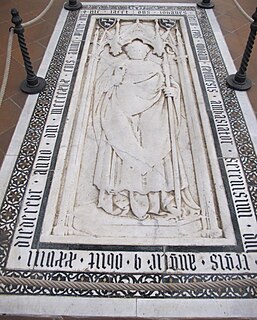Related Research Articles
Ælfheah, more commonly known today as Alphege, was an Anglo-Saxon Bishop of Winchester, later Archbishop of Canterbury. He became an anchorite before being elected abbot of Bath Abbey. His reputation for piety and sanctity led to his promotion to the episcopate and, eventually, to his becoming archbishop. Ælfheah furthered the cult of Dunstan and also encouraged learning. He was captured by Viking raiders in 1011 during the siege of Canterbury and killed by them the following year after refusing to allow himself to be ransomed. Ælfheah was canonised as a saint in 1078. Thomas Becket, a later Archbishop of Canterbury, prayed to him just before his own murder in Canterbury Cathedral in 1170.
Roger Walden was an English treasurer and Bishop of London.
Ælfheah is a given name. Notable people with the name include:
Marmaduke Lumley was an English priest, Bishop of Carlisle from 1429 to 1450, and Knight Commander of the Order of St. John of Jerusalem. He was a son of Ralph de Lumley, 1st Baron Lumley and Eleanor de Neville. He was elected about 5 December 1429, and consecrated on 16 April 1430. He was Bishop of Lincoln for a short time before his death in December 1450. He was educated at University of Cambridge and was appointed Precentor of Lincoln Cathedral in 1425. He also became Chancellor of the University of Cambridge in 1427 and was Master of Trinity Hall, Cambridge from 1429 to 1443. From 1446 to 1449 he served as Lord High Treasurer of England. Lumley's tenure as Lord High Treasurer occurred during the Great Bullion Famine and the Great Slump in England.

Edward Story was an English priest, Bishop of Carlisle, 1468–1477, and Bishop of Chichester, 1477–1503.
William Senhouse, also called William Sever, was an English priest, successively Bishop of Carlisle, 1495–1502, and Bishop of Durham, 1502–1505.
Ælfheah the Bald is the commonly used name for Ælfheah, the first English Bishop of Winchester of that name. He is sometimes known as Alphege, an older translation of his Old English name.
John Fordham was Bishop of Durham and Bishop of Ely.
Alphege was the third Anglo-Saxon Bishop of Wells. He was consecrated in January 926, and died around 937.

John Barnet was a Bishop of Worcester then Bishop of Bath and Wells then finally Bishop of Ely.
Nicholas Bubwith (1355-1424) was a Bishop of London, Bishop of Salisbury and Bishop of Bath and Wells as well as Lord Privy Seal and Lord High Treasurer of England.
Robert Reed was a Bishop of Waterford and Lismore, Bishop of Carlisle and Bishop of Chichester.
Thomas Polton was a medieval Bishop of Hereford, Bishop of Chichester, and Bishop of Worcester.

John Catterick was a medieval Bishop of St David's, Bishop of Coventry and Lichfield, and Bishop of Exeter.

Richard Redman was a medieval Premonstratensian canon and abbot of Shap Abbey, Bishop of St Asaph, Bishop of Exeter, and Bishop of Ely, as well as the commissary-general for the Abbot of Prémontré between 1459 and his death.
John Gilbert was a medieval Bishop of Bangor, Bishop of Hereford and Bishop of St. David's.
Richard de Wentworth was a medieval Bishop of London.

Richard FitzJames was a medieval Bishop of Rochester, Bishop of Chichester and Bishop of London.
Ælfsige was a medieval Bishop of Winchester. He was consecrated between 1012 and 1013. He died in 1032. In his will, he named Ealdorman Ælfheah as the guardian of his relatives and his last testament, as well as an estate at Crondall.
Beornstan was an English Bishop of Winchester. He was consecrated in May 931. He died on 1 November 934. After his death, he was revered as a saint.
References
- Fryde, E. B.; Greenway, D. E.; Porter, S.; Roy, I. (1996). Handbook of British Chronology (Third revised ed.). Cambridge, UK: Cambridge University Press. ISBN 0-521-56350-X.